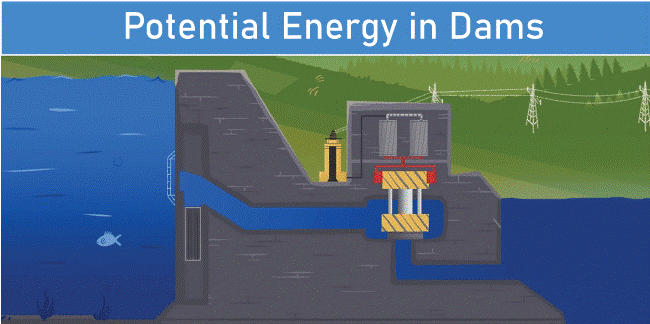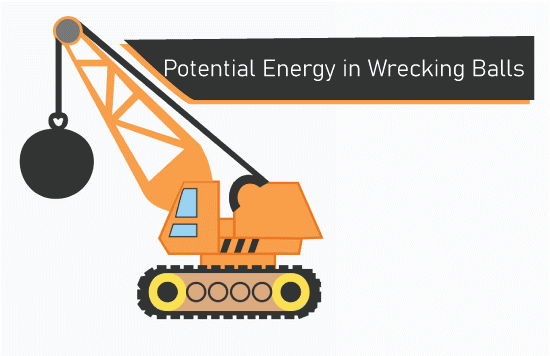Potential Energy DefinitionWhat is Potential Energy?Potential energy, or stored energy, is based on the position of different elements in an entire system. Spring will have more potential energy when stretched or compressed. Steel balls have more energy potential when elevated higher than when it falls to Earth. In its elevated position, it can do more work. Potential energy is a characteristic of a system and not of a single particle or body. The system that is composed of Earth and the ball raised is an example. It has greater potential energy since they are further apart. Potential energy is generated when systems have parts which exert force on one another, with a force that is dependent on the configuration or the relative positions, of the components. In the instance of the Earth-ball system, the gravity force between them is dependent on the distance between them. The work involved by separating them further, or elevating the ball adds more energy into the system, which is then stored as potential energy in gravitational potential energy. Potential energy also encompasses different other kinds. The energy stored between plates of charged capacitors is called electrical potential energy. The term commonly used to describe chemical energy, or the capability of a substance to work or evolve in heat through a change of its composition, could be thought of as potential energy that results from the forces that interact between the molecules and the atoms. Energy from nuclear sources is also a type of potential energy. The potential energy of a particle system depends solely on the initial configuration and the final one. It doesn't depend on the direction in which the particles travel. For instance, in the case of a steel ball and the Earth, if the initial location of the ball is at ground level and the final location is 10 feet higher than the surface, the potential energy remains the same no matter the method or way the ball was raised. The energy potential value is not fixed and is dependent on the reference point chosen. In the example above the system would possess twice the potential energy if its initial position was in the middle of a 10-foot hole. The energy of gravitation near the Earth's surface can be calculated by multiplying the mass of an object with its distance from the point of reference. For bound systems, for instance, like atoms in which electrons are held in place by the electric force of the nuclei, the zero point for energy potential is a distance away from the nucleus to the point that electric energy cannot be detected. In this scenario, bound electrons have negative potential energy, while the ones that are far away have no potential energy. Potential energy could be transformed into energy for motion, known as kinetic energy, and later into other forms, like electric energy. Therefore, water from dams flows into lower levels via turbines that turn electric generators, creating electricity, as well as some unutilized heat energy from friction and turbulence. In the past, it was believed that potential energy was combined with kinetic energy in the form of mechanical energy so that the total energy of the gravitational system could be determined as integral. By keeping in mind, the previously mentioned information regarding the potential energy source, we will take a look at some of the potential energy sources that we encounter in our daily lives- 1. Pendulum
Pendulums are structures where weight is suspended from a pivot so that they can easily swing, for instance, a clock pendulum. When a pendulum is placed on one side, it is able to generate the most potential energy because of its location. As we exit the bob, the potential energy is transformed into kinetic energy. The moment the bob of the pendulum reaches the opposite end, prior to returning on the same route it'll stop for about a moment at the point where it is the highest. In this stage of rest, the kinetic energy is converted to potential energy. This process repeatedly repeats until the pendulum stops. 2. SpringAs we have discussed previously, elastic potential energy is an energy form that is found in objects that are able to be stretched and compressed, for instance, springs. When springs are stretched or compressed and twisted, they will gain a certain amount of potential energy, referred to as elastic potential energy. The energy needed for the compression of the spring can be known as kinetic energy. If a spring is compressed and released, the potential energy stored in the spring that was compressed will transform into kinetic energy. 3. Bow & ArrowAre you aware that the operation of a bow and an arrow utilizes an initial law in thermodynamics which states that energy is not able to be created or be destroyed, but it is only moved from one type to the next and vice versa. As an archer pulls away on the bowstring, some amount of elastic potential energy is generated from the flexible limbs of the bow. The more the archer pulls back, the more potential energy is obtained by the limbs of the bow as a result of stretching. Once the bowstring has been released the arrow will move forward quickly. What happens is that the energy gained through bowstring stretching is quickly transferred to the bow in the form of kinetic energy. As a result, it is moving forward. 4. Rock at Cliff's EdgeA rock that is situated on the edge is a source of potential energy. The potential energy contained in that rock is because of its location. We know that the energy that is stored in the item due to its size is called gravitational potential energy. Therefore, we can conclude that the energy contained in the rock is the gravitational potential energy. If you push that rock down to the bottom of the mountain, that potential energy stored will transform into kinetic energy. Therefore, the next time that you go travelling to the mountains and you see a rock lying at the top of a cliff keep in mind that it is a source of gravitational potential energy. 5. Food We EatHave you ever thought about the way we can walk or run, or perform any task that requires an enormous amount of energy? What is the source of this energy that allows our bodies to perform all the work? Since we all know that working requires energy, we get our energy from the food that we consume. As was explained previously there is a form of energy that is present in the substance, which is known as chemical kinetic energy. It is energy that is stored within those chemical bonds in the substance. The food we eat is a storehouse of chemical energy. Once the food is consumed the chemical energy potential is transformed into the energy the body uses. It is said that everything composed of atoms is able to generate energy. It is interesting to note that if we have two meat pieces, both hot and cold, that weigh identically and then look them up, we'll observe that the hot one has more energy than cold meat due to the latter has a bit of extra thermal energy however, the amount potential energy remains the same. 6. Water in Dams & Reservoirs
The water held in dam reservoirs for a variety of reasons, such as generating electricity for hydropower plants and irrigation, preventing floods, industrial usage, human consumption as well as other industrial uses, has some amount of potential energy. Since the water in reservoirs remains at rest and is not allowed to flow through the reservoir, the energy that is contained within it will be referred to as potential energy. This is because we recognize the term "potential energy" refers to a type of energy that is present in things that are stationary. When the dam's gates open, the water that was previously still will immediately be moved, and the potential energy stored in the water will be converted into kinetic energy. 7. SnowHave you ever seen mountains covered with snow that look so serene? If there is fresh snowfall, the snow begins to cover the mountains. The snow that is in a state of rest contains a certain amount of potential energy within it. Since the mountains are at a certain height, this potential energy can be described as gravitational potential energy. If snow falls, the packed snow layer cracks, leading to an avalanche of snow. What happens during snow avalanches is that the energy potential transforms into kinetic energy. Therefore, snow starts sliding down the mountain quickly. 8. BulletWhen a shot is fired out of the weapon, it's in a state of the rest. We know that the energy that is present in a still object is called potential energy. This means that the bullets in rest inside the gun contain a certain amount of energy, which is referred to as potential energy. When the bullets go off, the potential energy is transformed into energy that is kinetic. 9. RollercoasterWhen a cart is held on the top of a rollercoaster just before it is permitted to free fall, the wagon is filled with a certain amount of potential energy. At the highest point on the rollercoaster, when the vehicle is slowed down for some seconds, the energy that is contained in the cart because of its height and the weight of the passengers inside the wagon is referred to as gravity potential energy. As more people are in the wagon, more will be gravitational energy. As the wagon moves further along the track, the potential energy stored is transformed into kinetic energy. 10. Rubber BandAs we stretch the rubber, it will store some potential energy within it. It is easy to claim that a rubber band has an energy storage capacity that is called elastic potential energy. When the band is stretched free, it returns to its original shape, and the energy stored as elastic potential is transformed into kinetic energy. 11. Wrecking Ball
Wrecking balls function in a similar way as pendulums. When a crane swings the wrecking ball until it reaches an appropriate level, it begins to gain potential energy. Like pendulums, in this instance also, the potential energy transforms into kinetic energy, which can then be utilized to smash structures. 12. SwimmerBefore diving into the water, swimmers must always remain on the board and extend. When the swimmers stand on the diving board, they are able to use some gravitational potential energy. When they plunge into the pool, this gravitational energy is converted to kinetic energy. This is the swimmer's leap while diving in order to get the maximum amount of gravitational energy that will then be transformed into kinetic energy. The higher the kinetic energy, the easier it is to cut through the viscosity of water in the pool.
Next TopicPreposition Definition and Examples
|
 For Videos Join Our Youtube Channel: Join Now
For Videos Join Our Youtube Channel: Join Now
Feedback
- Send your Feedback to [email protected]
Help Others, Please Share









